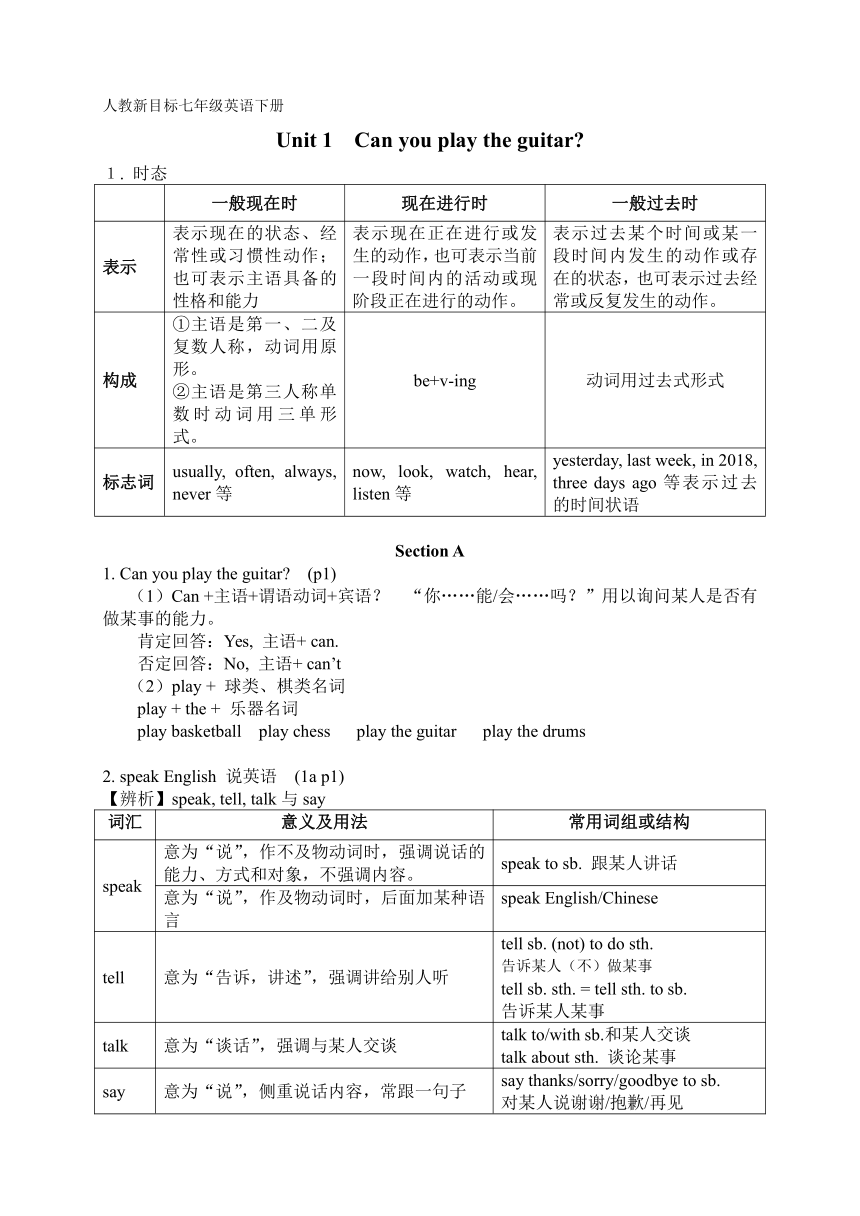
人教新目标七年级英语下册 Unit 1 Can you play the guitar 1. 时态 一般现在时 现在进行时 一般过去时 表示 表示现在的状态、经常性或习惯性动作;也可表示主语具备的性格和能力 表示现在正在进行或发生的动作,也可表示当前一段时间内的活动或现阶段正在进行的动作。 表示过去某个时间或某一段时间内发生的动作或存在的状态,也可表示过去经常或反复发生的动作。 构成 ①主语是第一、二及复数人称,动词用原形。 ②主语是第三人称单数时动词用三单形式。 be+v-ing 动词用过去式形式 标志词 usually, often, always, never等 now, look, watch, hear, listen等 yesterday, last week, in 2018, three days ago等表示过去的时间状语 Section A 1. Can you play the guitar (p1) (1)Can +主语+谓语动词+宾语?�———�你……能/会……吗?”用以询问某人是否有做某事的能力。 肯定回答:Yes, 主语+ can. 否定回答:No, 主语+ can’t (2)play + 球类、棋类名词 play + the + 乐器名词 play basketball play chess play the guitar play the drums 2. speak English 说英语 (1a p1) 【辨析】speak, tell, talk与say 词汇 意义及用法 常用词组或结构 speak 意为“说”,作不及物动词时,强调说话的能力、方式和对象,不强调内容。 speak to sb. 跟某人讲话 意为“说”,作及物动词时,后面加某种语言 speak English/Chinese tell 意为“告诉,讲述”,强调讲给别人听 tell sb. (not) to do sth. 告诉某人(不)做某事 tell sb. sth. = tell sth. to sb. 告诉某人某事 talk 意为“谈话”,强调与某人交谈 talk to/with sb.和某人交谈 talk about sth. 谈论某事 say 意为“说”,侧重说话内容,常跟一句子 say thanks/sorry/goodbye to sb. 对某人说谢谢/抱歉/再见 Mr. Smith can speak Chinese well. Can your grandma tell stories Mr. Lin says “I’m your new teacher.” Mary is talking with Jenny about her new teacher. 【拓展】talk to/with sb. 与…….交谈 talk about sth. 谈论某事 have a talk with sb. 和……谈一谈 speak to /with sb. 与……说话 tell to sb. 告诉某人 tell stories 讲故事 3.I want to join the art club. (1b p1) want to do sth. 想要做某事 want sb. to do sth. 想要某人做某事 join “参加”,加入某一组织或团体并成为其中一员。 join sb. 加入某些人中,和某人共同做某事 join sb. in sth. 加入到某人的活动中 take part in�———�参加”,多指参加某种活动。 4. What about you (2d p2) what about… = how about… “……怎么样?”用以询问消息、征求建议,后接名词、代词或v-ing形式。 5. You’re very good at telling stories. (2d p2) be good at = do well in “在……方面做得好,擅长于……”后接名词、代词、v-ing形式。 tell a story = tell stories 讲故事 tell sb. sth. = tell sth. to sb. 告诉某人某事 tell sb. (not) to do sth. 告诉某人(不要)做某事 6.Sounds good. (2d p2) sound(听), look(看),smell(闻), feel(摸), taste(尝起来)为感观动词,也可作连系动词,后可接形容词。 7. But I like to draw, too.(2d p2) too “也”,副词,常用于肯定句末,且其前有逗号与前句子其他部分隔开。 8. OK, let’s join now! (2d p2) let’s do sth. 让我们做某事吧! 9. Bill/write stories/tell stories (3a p3) write v.意为“写作,写字” writer n. 意为“作家” write to sb.=write a letter to sb. 意为“给……写信” 10. Can you sing or dance (3b p3) (1)这一个选择疑问句,指提供两种或两种以上情况,问对方选择哪一种的疑问句。构成方式:一般疑问句+ ... ...
~~ 您好,已阅读到文档的结尾了 ~~